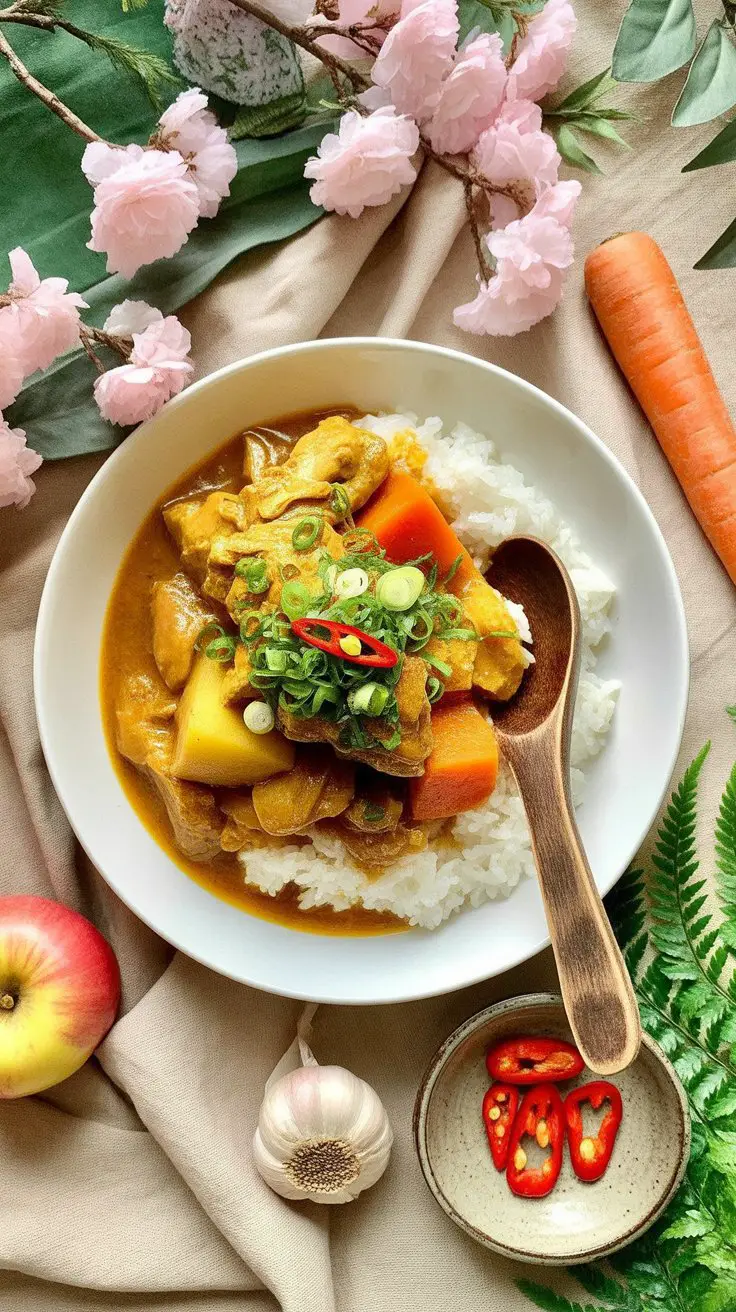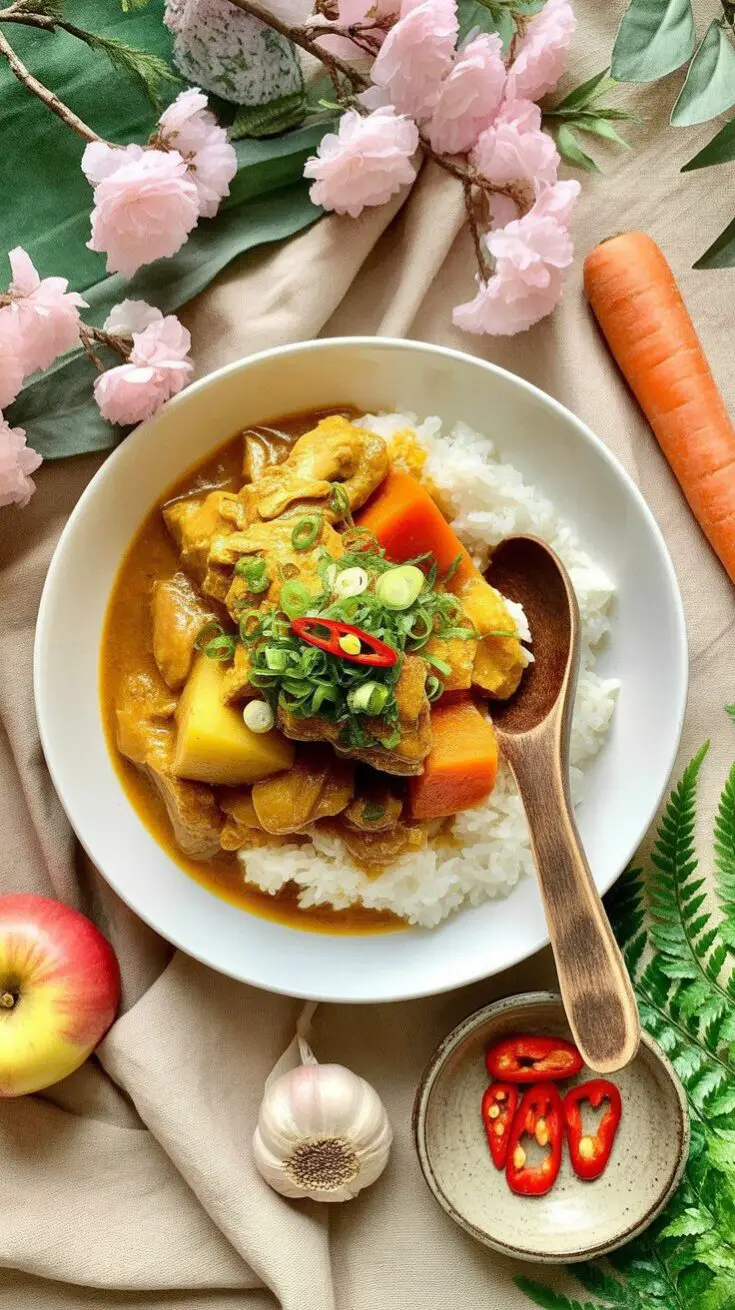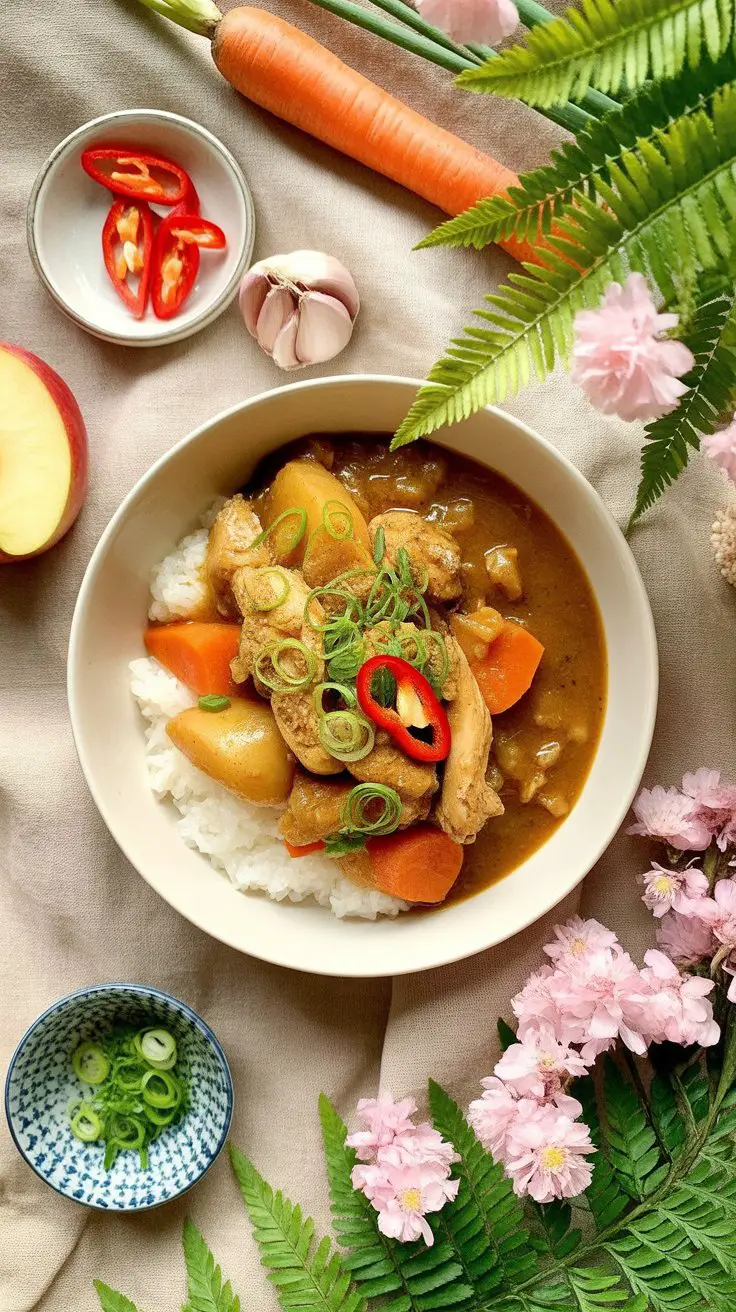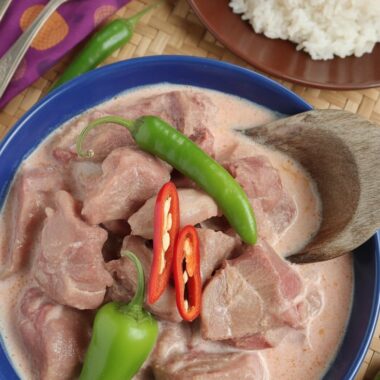Japanese curry has always felt like a hug in a bowl for me. The first time I made it, I was a broke student craving something hearty but not complicated, and I remember being amazed at how much flavor came out of just a box of S&B Golden Curry roux, some pork, and a handful of vegetables. It’s the kind of dish you’ll want to repeat because it’s comforting, filling, and endlessly adaptable.
 It’s not fussy—just a bit of sautéing and simmering—and it gives you a full meal in one pot: tender meat, soft vegetables, and that silky curry sauce that clings to rice in the best way. The sweetness from the apple and carrots balances the gentle spices, making it a dish that both kids and adults love. And if you like playing around in the kitchen, you can adjust the spice level or swap proteins without ever losing that “cozy home-cooked” vibe.
It’s not fussy—just a bit of sautéing and simmering—and it gives you a full meal in one pot: tender meat, soft vegetables, and that silky curry sauce that clings to rice in the best way. The sweetness from the apple and carrots balances the gentle spices, making it a dish that both kids and adults love. And if you like playing around in the kitchen, you can adjust the spice level or swap proteins without ever losing that “cozy home-cooked” vibe.
Ingredients You’ll Need
Here’s what usually goes into my pot of Japanese curry—and a few notes from experience:
Japanese curry roux mix: I usually stick to S&B Golden Curry, but House and Vermont Curry are solid choices too. I keep a box of the medium-hot version in my pantry at all times—it’s like my rainy-day insurance meal.
Pork: Pork shoulder works beautifully, but chicken thighs are quicker if you’re short on time. Beef gives it a richer depth if you want something heartier. Tofu actually soaks up the sauce surprisingly well too.
Onion: White, yellow, or even red—use what you have. I’ve even used shallots when I ran out, and it worked fine.
Garlic & Ginger: Fresh makes a difference here—it really builds the base flavor before the curry roux goes in.
Apple: This is the little “secret” ingredient. A grated Fuji apple gives the curry a gentle sweetness and ties in perfectly with the store-bought roux. Skip it and the curry will still be tasty, but you’ll miss that little layer of depth.
Carrots & Potatoes: Carrots are classic, and potatoes turn it into a stick-to-your-ribs kind of meal. Just be mindful—if you add too many water-rich veggies like mushrooms, you’ll need to simmer longer or reduce the water.
Optional add-ins: A splash of soy sauce, Worcestershire, or even a spoon of ketchup can round out the flavors. I once added leftover roasted peppers and it was excellent.
Garnishes: Freshly cracked black pepper, green onions, or pickled daikon (if you want to keep it more traditional).
And of course, rice. Fluffy white rice is the standard, but I’ve served it with brown rice when I wanted something nuttier, and cauliflower rice when I needed something lighter.
How I Cook It Step by Step
Build the base – I heat oil in a deep pan and let the onions soften until golden. If I’ve got the patience, I cook them low and slow until caramelized—it gives the curry a sweeter, rounder flavor.
Aromatics next – Garlic and ginger go in, just for a quick sauté until fragrant.
Cook the meat – Pork cubes get stirred in and browned. If I’m using beef, I take the time to get a good sear for extra flavor.
Simmer with water (or stock) – Add water and bring it to a boil, then skim off the foam. On days I have homemade chicken stock, I use that instead, and it makes the curry taste like I spent hours on it.
Vegetables in – Carrots (and potatoes if using) simmer until tender.
Sweetness boost – I stir in grated apple. It sounds unusual if you’ve never tried it, but trust me—it melts into the sauce.
Roux magic – I break the curry roux into smaller chunks and stir them in gradually, letting them dissolve. The sauce thickens into that glossy, spoon-coating curry. If it ever gets too thick, I just splash in a bit more water until it’s perfect.
By the end, the whole kitchen smells warm and inviting, and I usually find myself stealing spoonfuls before it even reaches the plate.
 Keeping and Reheating
Keeping and Reheating
This curry is a lifesaver for meal prep. I often make a big pot on Sunday and reheat it through the week. By day two or three, the flavors deepen and it tastes even better.
Fridge: Keeps well in an airtight glass container for 2–3 days. I recommend glass because the turmeric in the roux will stain plastic.
Freezer: Portion it into smaller containers and freeze for up to a month. Reheat on the stove with a splash of water to loosen the sauce.
Tips I’ve Learned Along the Way
If you have food intolerances, you can make a homemade roux from scratch with flour, butter, and spices, then use chicken stock instead of water.
Keep an eye on the ingredient balance. I once got carried away adding extra veggies, and the curry turned out more like a soup.
Try butter instead of oil for sautéing the onions if you want a richer, creamier finish.
Common Questions
Can I skip the apple?
Yes, but I wouldn’t recommend it. The apple doesn’t make it taste fruity—it just rounds out the flavor.
Can I use chicken breast instead of thighs?
You can, but it cooks faster, so add it later in the simmering stage to keep it from drying out.
Can I make it vegetarian?
Absolutely. Replace the meat with tofu, mushrooms, or even chickpeas. Just adjust the simmering time so the veggies don’t break down too much.
 Serving Ideas
Serving Ideas
I love keeping it classic with plain steamed rice, but there are so many fun ways to serve Japanese curry:
Over a breaded pork or chicken cutlet (katsu curry).
With thick slices of toasted Japanese milk bread to mop up the sauce.
Ladled over mashed potatoes for a cozy twist.
Paired with a crisp side salad or pickled vegetables to cut through the richness.
It’s one of those dishes you can make for a weeknight dinner, but it’s equally welcome at a casual gathering with friends. I once served it for a potluck, and it was the first dish to disappear.
Japanese Curry (S&B Golden Mix)

A hearty bowl of Japanese curry is the ultimate comfort dish—rich, slightly sweet, and full of flavor. This easy version, made with S&B Golden Curry roux, is a go-to weeknight meal that pairs perfectly with fluffy white rice.
Ingredients
- 3–4 lbs pork shoulder, cut into bite-sized pieces
- 1–2 tablespoons vegetable oil (or butter)
- 1 onion, thinly sliced or minced
- 2 cloves garlic, minced
- 1 inch fresh ginger, grated
- 2½ medium carrots, cut into rounds
- 4 cups water (or use chicken stock/dashi for more depth)
- 1 apple, peeled and grated (or 1 tablespoon sugar/honey as a shortcut)
- 1 pack Japanese curry roux (S&B Golden Curry or similar), broken into pieces
- Optional: potatoes or other vegetables of choice
- Cooked rice, for serving
Instructions
- Heat oil or butter in a deep pan over medium heat. Add the onions and cook until soft and golden; for extra depth, take your time and let them caramelize slowly.
- Stir in the garlic and ginger, cooking just until fragrant. Add the pork and sear until its color changes and it begins to brown lightly.
- Pour in the water or stock and bring to a boil. Lower the heat to a gentle simmer, skimming off any foam that rises to the surface.
- Add the carrots—and potatoes if using—and simmer until the vegetables are tender.
- Mix in the grated apple for natural sweetness. Keep the heat low, then gradually add the curry roux pieces, stirring until each portion dissolves before adding more.
- Let the curry simmer until thickened and silky, stirring now and then to prevent sticking. Adjust the consistency with a splash of water if needed.
- Serve piping hot over steamed rice and garnish as you like. Leftovers taste even better the next day!
Nutrition Information:
Yield: 6 Serving Size: 1Amount Per Serving: Calories: 7888Total Fat: 579gSaturated Fat: 206gTrans Fat: 0gUnsaturated Fat: 319gCholesterol: 2326mgSodium: 1787mgCarbohydrates: 25gFiber: 3gSugar: 6gProtein: 605g
Asianplated.com, occasionally offers nutritional information for recipes contained on this site. This information is provided as a courtesy and is an estimate only. This information comes from online calculators. Although allchickenrecipes.com attempts to provide accurate nutritional information, these figures are only estimates.
Final Thought
For me, Japanese curry is the definition of simple comfort cooking. It’s the kind of recipe you can make after a long day, with just a few pantry staples and some rice. It feels cozy, nostalgic, and just plain satisfying.
If you’ve never tried making it at home, I promise you’ll be surprised by how easy and rewarding it is. And once you’ve made it once, you’ll probably find yourself keeping a box of curry roux in your pantry, just like I do.
Try other Japanese recipes:

 Keeping and Reheating
Keeping and Reheating Serving Ideas
Serving Ideas















